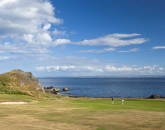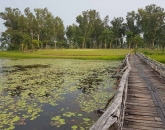Early Scottish courses didn't have a standard number of holes. Some had five, others had seven; the Old Course first had eleven and then twenty-two: eleven holes out and eleven back, with golfers playing to the same hole going out and in, except for the eleventh and twenty-second holes. In 1764, it was decided that the first four holes – and therefore the last four holes – were too short and that they should be made into two holes instead of four. This reduced the number of holes in the round to eighteen – and, among other things, removed the inconvenience for townspeople who wanted to get to the beach and presented the Royal and Ancient Golf Club with a superior location for their clubhouse, which was built in 1854. With the growing influence of the R&A on the global game, eighteen holes became standard. The number has nothing to do with the number of drams in a whisky bottle.
The Origin of Double Greens
Until around 1850, play on the Old Course took place in both directions – the routing lends itself to reversibility. But in the 1850s, the railroad’s arrival and the invention of the cheaper and more durable “guttie” ball led to more feet stomping down the gorse and heather that lined the holes, not to mention increased traffic around each green’s cup, which served both inward- and outward-bound players. In 1856, greenkeeper Allan Robertson began to cut a second hole in each green, and the next year both the greens and fairways were expanded to accommodate the new visitors. The transformation was almost complete by 1870, when Old Tom Morris constructed a new first green (prior to this, the seventeenth green had also served as the first). Since then, the creation of new back tees has formalized the right-hand course as the championship layout, leaving the clockwise “reverse course” as a curiosity that is only open for play a few days a year.
Who was Grannie Clark?
Grannie Clark's Wynd, the road that bisects the first and eighteenth fairways, is very much an integral part of the course, and a definite oddity unique to St Andrews. It is thought that no other championship course has a public road crossing two of its holes and golfers who have the misfortune of having their ball end up on the road must play it as it lies or take relief under penalty. But who was Grannie Clark? According to historian David Joy, "The Clarks had a cottage on the communal drying green [an area next to the lifeboat house where townspeople dried their laundry], and from about 1830 to the 1860s Grannie Clark supervised the activity around that site and provided endless cups of tea, sandwiches and so on.”











